Editorial
My bad. The Model Engine News "dot org" domain went unregistered for half a day towards the start of August. All my own fault—the email address the reminder notice should have gone to had been closed down. I found the problem fast (and registered the domain for another five years), but as the domain had been dropped from the registrar's name servers, this sad state of affairs propagated outwards like a ripple in the proverbial pond. Depending on where you were and what twisty little chain of name servers your ISP uses, it could have looked like MEN was gone for a couple of days! Thanks to all who emailed asking if I was still alive. If I didn't reply, it's because the name server problem also made it impossible to send mail to modelenginenews.org and I suspect some got lost instead of stored and forwarded later. Sorry. Won't Happen Again.
And I'm most pleased to say that August in south-east Queensland brought the best rain-fall we've had in ten years. While the drought is in no way broken, the authorities are saying that the level in the reservoirs has risen to the 20% level. This gains us a three month reprieve from the pending "Level Six" water restrictions. If our luck holds, the delay will take us into what should be the normal wet season, but has not been for an awful long time. But things will never return to normal. It's plain we have inadequate infrastructure, changing weather patterns, and a rapidly increasing population due to migration from other states, all leading to permanent water problems and restrictions. Oh well... at least I can remember the good old days when you could indulge in a long hot shower without a trace of guilt.
Speaking of guilty pleasures, it's been a while since I've had a nice, satisfying, and completely useless anti-microsoft rant, so it must be time. In the past month, my "professional" research has led me to delve deeply into the more recent changes to the Cascading Style Sheet (CSS) specification. To quickly give you more information that you really need, these are "invisible" web content files referenced by HTML pages like this one that can be used to control the layout and appearance of a web document, the latter merely supplying the words. By using a style sheet, it becomes possible to change the look of a whole stack of HTML pages without actually making any changes to the pages themselves. The CSS specification is defined and maintained by a standards body called The World Wide Web Consortium, or the W3C for short.
Now, did you notice a little external link icon after the previous link? It looks like this:  . If you are using a Mozilla-based browser like Firefox, you will have, but if—like 70% of visitors to this site—you use Microsoft's Internet Explorer, you won't have because as usual, they have elected to ignore the W3C standard. So Firefox users now get a hint when a link will take them to another web site, but IE users don't. I could fix this, but it would mean editing just about every page on this site—all 657 of them. Now you see why some pages contain the tag This site best viewed using anything except IE! To be fair, IE does render text better than Firefox, but I think the cost is too great. Anyway, I should stop ranting now and get down to business...
. If you are using a Mozilla-based browser like Firefox, you will have, but if—like 70% of visitors to this site—you use Microsoft's Internet Explorer, you won't have because as usual, they have elected to ignore the W3C standard. So Firefox users now get a hint when a link will take them to another web site, but IE users don't. I could fix this, but it would mean editing just about every page on this site—all 657 of them. Now you see why some pages contain the tag This site best viewed using anything except IE! To be fair, IE does render text better than Firefox, but I think the cost is too great. Anyway, I should stop ranting now and get down to business...
Hemingway Correction
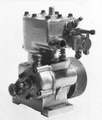
Last month, Hemingway's IC kit Catalog was mentioned saying that they had no secure on-line ordering facility. Well, as gently pointed out by Hemingway's head honcho, Kirk H Burwell, this turns out not to be the case. My mistake was to just download the PDF version of the IC engine catalog. If you go to the On-line Hemingway Catalog, you'll find the full-blown shopping-cart and secure check-out facility we've come to expect. Setting up one of these for an inventory the size of Hemingway's is no small task and shows Kirk's commitment to model engineers everywhere. As for the Whippet noises originally heard coming from under the bench, they seem to be getting louder, and my resistance is weakening...
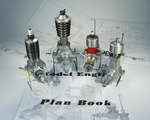
As a side-effect of this month's Tech-Tip on Two-stroke timing calculations, five of the general arrangement sheets in the Motor Boys Plan Book have been revised. In the worst case (the Scrapper 29), the timing was just plain wrong. In others, the timing diagram has been amended to standardize it with the format produced by the Timing Calculator. So click this link to the Plan Book Updates page where you can view or download a DPF document containing four replacement GA sheets. If you don't have a copy of the book, have a look anyway—the GA's may convince you to buy it! And remember, not a cent of sales goes to us; it all goes to encourage junior modelers through the AMA.
Engine Review Updates

A vague sense of unease comes over me when in the process of putting together an engine review, I gather enough data to produce a timing diagram, but don't. As a software engineer—hopefully a good one—I am, by definition, lazy. Producing timing diagrams is labour intensive. The math is not hard, especially with something like a spreadsheet, but formatting the results takes an age. Having to revise an existing one is even worse. Well all that is now in the past! In planning the components for this month's Tech Tip, one goal was to design the code that produces the timing diagrams so calls to it could be embedded in other pages. This is easy to do, and easy to revise. The result is a timing diagram rendered in the site's look and feel that looks like a lot of work, but isn't (told you I was lazy). Now future reviews can have a link—a button, actually—that takes the viewer to a nice little page showing the timing events and other interesting data. As a test, this feature has been retrofitted to a number of existing reviews representing the spectrum of induction types supported. The modified pages appear in the "New and Updated" section of the Finder. Generally, the button will appear just after the info block on the page, but if the page is not to the "card file" standard, you may need to hunt about a bit for it.
Starting Variable and Fixed Compression Diesels
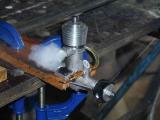
The Frequently Asked Questions (FAQ) page has had a minor but significant overhaul. The first question on the page concerns the fuel used by model "diesels". This contained an oddity in the form of the manufacturer's warning regarding the fuel to be used in the Drone diesel if damage was to be avoided. The fuel mix specified went against almost everything accepted as common wisdom for diesel fuel. All is now explained and Drone is correct, but then, so is the "standard" mix! This disagreement is resolved by the fact that the Drone in question is a fixed-compression engine, thus making it subtly different in fuel requirements and operation from a variable compression engine. So visit FAQ QA#1 to get the background, then read through FAQ QA#9 on starting a diesel which has been expanded to include chapter and verse on fixed compression diesels as well as the variable variety. Thanks go to Adrian Duncan for sharing all his hard earned knowledge on FC diesels, adding to Ken Croft's simple and effective technique for their variable compression brethren (that's Ken's Delong Diesel caught puffing smoke in the picture). If you can't wait, click here for the fixed compression diesel operations page.
New Watzit Page
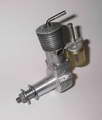
Time to turn the page. After The Engine Gallery pages, the Watzit Pages are right up there as one of the most popular items on this web site. In comparison, stuff like build articles, painstakingly researched and presented discourses on technical matters, etc are down in the noise. Still, keeps me off the streets. Anyway, to keep download times sane, Watzit fans get a brand, new Watzit page this month. It kicks off with an engine we don't have an answer for, so if you do, please let us know. There's also some new entries in the current gallery page, and a fix has been applied that prevented Firefox from indexing correctly into the entries on the Gallery pages. Previously, Firefox went to the top of the page instead while IE, being less correct in interpreting the HTML, actually went where I wanted it to—a case of two wrongs making a right. I'll gradually apply this fix all over the site, bu that will take time and effort, so for now, just see the Updated and New Page Index to see what ones have been attended to,
AMEE Price Reduction
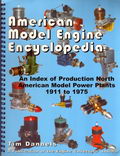
The American Model Engine Encyclopedia was reviewed here exactly two years ago (how time flies). This is a must-have reference for collectors and if you don't have it, you can now repair this deficiency at a reduced price. About a year ago, Tim Dannels, author of the AMEE and editor/publisher of the Engine Collectors' Journal for the past 44 years, launched the Model Engine Collecting web site. I just noticed (Tim is far too civilized to actually tell me) that the AMEE is now priced at US$40, down from $49.95 (postage extra). You can also place or renew ECJ subscriptions on-line from the web site. I'm not exactly un-biased as Tim is a fellow Motor Boy and friend, but I truly believe you will not be disappointed if you buy this book.
Cirrus Mk I Update
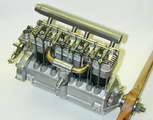
No, I *still* haven't made a mount for it, nor done the required final tear-down, clean-up, re-assemble. Blame total Cirrus burn-out after the epic EDM saga. But I've been asked by a reader to shake the bushes for prospective Zimmerman Cirrus builders. Seems that Chester DuBiel (the guy I got my castings from way back when) could still supply casting sets if he gets enough advance orders to make the proposition viable at the foundry he uses. This is the 1/4 scale version; ie not the 1/6 scale version covered here in the Cirrus Mk I Project pages, although the construction is similar. The cost would be US$235 per set (postage extra). Chester does not use email, so you'll need to write to him at the address below.
Mr Chester DuBiel
7010 Arcadia Drive
Pama OH 44129
USA
New Books and Magazines This Month
Real airplanes, so the saying goes, have two wings and round engines. The trio on the cover of this month's book are Hawker Tomtits, fitted with Wolseley AR9 radials, as entered in England's King's Cup Air Races during the mid-1930's. Today, this engine and it's descendants are rather obscure. I noticed them first while reading Slide Rule, Nevil Shute Norway's autobiography. Norway's company, Airspeed Ltd, was responsible for designing one of the first British aircraft to have retractable undercarriage—and yes, Mr Norway's alter ego, "Nevil Shute" is the well known fiction author; see the reviews of "Slide Rule", and "Trustee from the Toolroom" for why this is so).
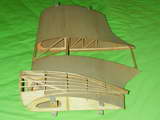 In "Slide Rule", Norway heaps great praise on the Wolseley radials and attributes their sudden and somewhat petulant removal from the marketplace as a contributor in Airspeed's ultimate decline. This small observation, plus a partially built Aeromodeller Airspeed Envoy stick and tissue, twin engine scale rubber model that is gathering dust in my modeling room perked my interest when I spotted the Nuffield book on the AEHS web site. The Internet being a powerful magnet for impulse buying, a copy was soon in my hands and provides the subject for this month's book review.
In "Slide Rule", Norway heaps great praise on the Wolseley radials and attributes their sudden and somewhat petulant removal from the marketplace as a contributor in Airspeed's ultimate decline. This small observation, plus a partially built Aeromodeller Airspeed Envoy stick and tissue, twin engine scale rubber model that is gathering dust in my modeling room perked my interest when I spotted the Nuffield book on the AEHS web site. The Internet being a powerful magnet for impulse buying, a copy was soon in my hands and provides the subject for this month's book review.
 Wolseley Radial Aero Engines: Lord Nuffield's Thwarted Venture, by Peter Seymore, Tempus Publishing (England), 2006, ISBN 0 7524 3915 4, soft-bound, 194 pages with extensive photographs, drawings interspersed in the text. The title rather gives the ending away, doesn't it? First, I think this is a terrific book and I enjoyed it immensely for all the gaps in my knowledge of the world it managed to fill in—several of which I even didn't know existed! One of these is the answer to just who in 'el Lord Nuffield was and why this is important. He was born William Morris in October 1877, in rather humble circumstances. Ever heard of Morris cars, or the MG, SU carburetors, etc, etc? Yes, he was that Morris. When elevated to the peerage in 1934, he chose "Nuffield" (taken from the name of a small village in Oxfordshire near his home) as there already was a Lord Morris. All this is very well detailed in the book's extensive appendices, as are the dates and details of the company acquisitions and mergers he shrewdly conducted, plus backgrounds on other famous Persona Dramatae involved in that story.
Wolseley Radial Aero Engines: Lord Nuffield's Thwarted Venture, by Peter Seymore, Tempus Publishing (England), 2006, ISBN 0 7524 3915 4, soft-bound, 194 pages with extensive photographs, drawings interspersed in the text. The title rather gives the ending away, doesn't it? First, I think this is a terrific book and I enjoyed it immensely for all the gaps in my knowledge of the world it managed to fill in—several of which I even didn't know existed! One of these is the answer to just who in 'el Lord Nuffield was and why this is important. He was born William Morris in October 1877, in rather humble circumstances. Ever heard of Morris cars, or the MG, SU carburetors, etc, etc? Yes, he was that Morris. When elevated to the peerage in 1934, he chose "Nuffield" (taken from the name of a small village in Oxfordshire near his home) as there already was a Lord Morris. All this is very well detailed in the book's extensive appendices, as are the dates and details of the company acquisitions and mergers he shrewdly conducted, plus backgrounds on other famous Persona Dramatae involved in that story.
In addition to being a very smart businessman and industrialist, Nuffield was a talented engineer and a truly generous philanthropist. The book primarily chronicles his foray into aero engine design and manufacture, but to understand this, the rest must be told. The "thwarted" part of the title reflects the end of this venture occasioned by a directive that in order to sell engines to the government for military use, he would have to sell at whatever price they decided to pay under an "Instruction To Proceed". This directive was issued by the Air Minister, Lord Swinton, assisted by Lord Weir, the latter being responsible for the ABC Dragonfly engine debacle at the close of World War I (I'll review books explaining this later). This experience may have led to Weir's caution and the high-handed attitude to purchase evidenced in the ITP terms. While other manufacturers had to grin and bear it, Nuffield had neither board of directors, nor shareholders to answer to, so ceased manufacture rather than submit. This makes him seem rather autocratic. He undoubtedly was, but he was also generous and fiercely patriotic as evidenced by the many, many contributions he made to Britain's war effort, not infrequently at his own considerable expense. Like all things, his unilateral decision to stop making the rather nice and well developed Wolseley radials was more complex than it appears. But you need to read the book to really understand it all.
If you like stories like this, you'll enjoy this book. It also helps fit lots of other names into the jigsaw puzzle, two of whom have an Australian connection: Fredrick York Wolseley, and Herbert Austin (again, both famous makers of automobiles). Wolseley, an Irishman, emigrated to Australia in 1854 where he started the "Wolseley Sheep Shearing Machine Co Ltd" (1887). Austin had arrived in 1884 and joined the Sydney-based company to improve the mechanical reliability of their product. Ultimately they all, company included, moved back to England, to be acquired later by Morris. It's a great yarn;  Five stars, sadly not available from Amazon, but you can order from the publishers' website.
Five stars, sadly not available from Amazon, but you can order from the publishers' website.
Howell V4
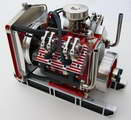
Now isn't that just the prettiest little thing you ever saw? It's a 90° V4 four-stroke designed by Jerry Howell and features on his Model Project Plans and Kits website. The displacement is 32cc and it's a barstock engine featuring "blade and fork" conrods. This allows the cylinders to sit side by side (ie, no stagger). Not so obvious is the full pressure fed lubrication system and magnetically coupled water pump. The outstanding use of color and polished machining really sets off the finish. The exposed rockers add to the crowd appeal too. Plans and construction notes are US$63.00 from Jerry (full contact details on the Suppliers Page). Go to Jerry's web site where you'll find a stack more photos and details. Incidentally, Joe Martin and the team at the Craftsmanship Museum are narrowing down the choices for their next project and this one is starting to look very good to all concerned.
Engine Of The Month: Thorning Monsunen
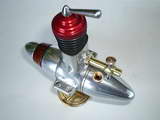
Drawing CAD plans for this has occupied almost all my "shop" time in the past month. The engine itself is a streamlined, yet seeming simple looking side-port diesel that appeared in Denmark around 1945. The plans require fifteen A4 sheets to detail all the complicated parts required in metric and Imperial measurements. They are now complete and case castings are the next step. This engine positively begs for Les Stone's skill and ability in bringing out the finish. Les agreed and could not wait, so even before the CAD was done, he had the engine well advanced using the rather inaccurate original drawings. All agree that he's out-done himself on this one, and in record time, rushing to get it completed and run by "press time". Les' Monsun has some unique features too, such as a forward facing exhaust. There is good reason for this as you can read on the Thorning Monsun page.
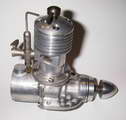
But wait! There is—as they say in the classics—more! Mr Adrian Duncan, mentioned above, has kindly provided a number of engine reviews with photographs and insights from his extensive collection (around 800, he thinks). As well as covering subjects that are a bit out of the usual, these reviews will provide welcome life-savers in those months where I'm pressed for time by other projects. He has intelligently stepped through the Finder looking for places where I have only an isolated picture with no words, as well as subjects which are rather rare. As a nod to the established Model Engine News standard for historical background on model engines, I'll add magazine advertising scans etc to the reviews, and the odd word or two (can't help myself apparently). You can try to figure out where Adrian stops and Ron starts. To kick this all off, the Finder entry for the English BMP 3.5cc TBR diesel has been expanded to a full review, and the charming little Amco 87 added. There are lots more in the pipeline for later. As an assist to differentiation, Adrian's reviews will have a slightly different layout style to the others. Hope you like it.
Tech Tip of the Month
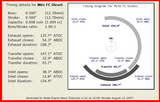
As a follow-on from last month's dissertation on FRV hole cutting, I've added pages that will calculate the timing events for the three most common types of model two-stroke inlet schemes: Side-port, Front Rotary Valve (FRV), and Rear Rotary Valve. This was done with a certain reluctance as I'm less than sure of the true worth of things like this. There are just so many possible real-world variations in engine designs that a truly generic calculator would require a bewildering array of options, many of which would be mutually exclusive. The result would be something only the original designer could use. At the other extreme, dumbing it down to simple cases only would make it equally useless. But I keep being asked for something like this by readers, so let's see how much use it gets, and how much use it is!
It must be pointed out that timing alone is no real indication of any model engine's potential performance. Modern commercial products are generally very well designed with port size and locations working together to balance flow within the engine. Overall performance also depends on pumping volume and other factors, so changing timing on engine "A" to match engine "B" just because that one revs faster may have exactly the opposite effect! That said, amateur designers whose engines which will not undergo the rigorous development program commercial products are subjected to may benefit by being able to see what sort of "numbers" a given geometry produces.
There are limitations. The input data does not allow for DeSaxe configurations, and you need very precise measurements, some of which are difficult to obtain on an actual engine. Things like port lip heights relative to the crankshaft axis for instance. Little things like the compressed gasket size can cause uncertainty, as can determining where that non-physical central axis actually is in relation to the cylinder seat! This is especially true for small engines where a difference of a mere one thou (0.001") can change the timing by more than one whole degree. The effect is less with larger displacement engines, but it's a good idea to measure several times and average the results.
For the technically curious, under the hood there is only one calculator program, plus an associated graphics rendering program. The parameters required for the engine type are collected and supplied by three different forms. Each of these has descriptions of the values required, but what seems blindingly obvious to me may be less so to you! So if you encounter difficulty understanding the parameter descriptions, assume it's the designer who is the stupid one and send me an email. This will allow the pages to be fine-tuned, making them more usable for all.
Naturally, the pages appear on this month's DVD update in the password protected Members' Section, but you must have setup a local web server with PHP enabled, and have it running for them to work. I have tested them with the XAMPP package that is recommended for local DVD setups (now included on the DVD) and all works fine for me. Provided you have got the "Find" facility to work on your local MEN setup, you should have no problems. But this is relatively complex stuff, so don't be afraid to ask questions.
The ED Story Part II
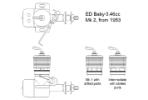
Where is it you ask? Well, of the two Ronnies, author Ron Reeves did his part on time and forwarded notes and CAD 3-views of all the ED engine offerings to Ron Chernich (that's me) for composition into MEN-standard web pages. What can I say except "failed totally". Rest assured, all the images and text, along with the magazine scans I've collected on the ED radios, kits and accessories, will go on a lap-top and travel with me to Bucharest this month. Forty-four hours of cattle-class, DVT inducing international air travel. I'm really, really looking forward to it (not). In the mean time, if you read the ED Story early in August, you might like to have a look again at the part that deals with the Cornell years as Gordon passed extra stuff to Ron Reeves and the page has had a spot of expansion for the 1958-62 period.
 Hemingway Correction
Hemingway Correction
 MBI Plan Book Download
MBI Plan Book Download
 Engine Review Updates
Engine Review Updates
 Starting Variable and Fixed Compression Diesels
Starting Variable and Fixed Compression Diesels
 New Watzit Page
New Watzit Page
 AMEE Price Reduction
AMEE Price Reduction
 Cirrus Mk I Update
Cirrus Mk I Update
 Howell V4
Howell V4
 The ED Story, Part II
The ED Story, Part II
 Editorial
Editorial
 New Books and Magazines This Month
New Books and Magazines This Month
 Engine Of The Month: Thorning Monsunen
Engine Of The Month: Thorning Monsunen
 Tech Tip of the Month
Tech Tip of the Month
 Standard Stuff
Standard Stuff









 Five stars, sadly not available from Amazon, but you can order from the
Five stars, sadly not available from Amazon, but you can order from the 



